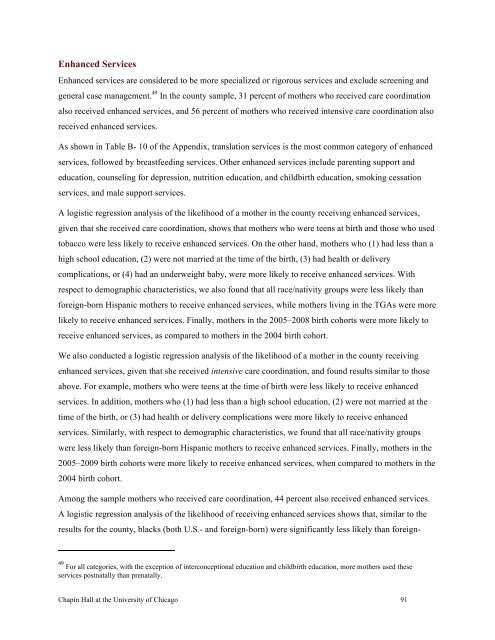2011 The Palm Beach County Family Study (Full Report)
2011 The Palm Beach County Family Study (Full Report)
2011 The Palm Beach County Family Study (Full Report)
- No tags were found...
You also want an ePaper? Increase the reach of your titles
YUMPU automatically turns print PDFs into web optimized ePapers that Google loves.
Enhanced ServicesEnhanced services are considered to be more specialized or rigorous services and exclude screening andgeneral case management. 49 In the county sample, 31 percent of mothers who received care coordinationalso received enhanced services, and 56 percent of mothers who received intensive care coordination alsoreceived enhanced services.As shown in Table B- 10 of the Appendix, translation services is the most common category of enhancedservices, followed by breastfeeding services. Other enhanced services include parenting support andeducation, counseling for depression, nutrition education, and childbirth education, smoking cessationservices, and male support services.A logistic regression analysis of the likelihood of a mother in the county receiving enhanced services,given that she received care coordination, shows that mothers who were teens at birth and those who usedtobacco were less likely to receive enhanced services. On the other hand, mothers who (1) had less than ahigh school education, (2) were not married at the time of the birth, (3) had health or deliverycomplications, or (4) had an underweight baby, were more likely to receive enhanced services. Withrespect to demographic characteristics, we also found that all race/nativity groups were less likely thanforeign-born Hispanic mothers to receive enhanced services, while mothers living in the TGAs were morelikely to receive enhanced services. Finally, mothers in the 2005–2008 birth cohorts were more likely toreceive enhanced services, as compared to mothers in the 2004 birth cohort.We also conducted a logistic regression analysis of the likelihood of a mother in the county receivingenhanced services, given that she received intensive care coordination, and found results similar to thoseabove. For example, mothers who were teens at the time of birth were less likely to receive enhancedservices. In addition, mothers who (1) had less than a high school education, (2) were not married at thetime of the birth, or (3) had health or delivery complications were more likely to receive enhancedservices. Similarly, with respect to demographic characteristics, we found that all race/nativity groupswere less likely than foreign-born Hispanic mothers to receive enhanced services. Finally, mothers in the2005–2009 birth cohorts were more likely to receive enhanced services, when compared to mothers in the2004 birth cohort.Among the sample mothers who received care coordination, 44 percent also received enhanced services.A logistic regression analysis of the likelihood of receiving enhanced services shows that, similar to theresults for the county, blacks (both U.S.- and foreign-born) were significantly less likely than foreign-49 For all categories, with the exception of interconceptional education and childbirth education, more mothers used theseservices postnatally than prenatally.Chapin Hall at the University of Chicago 91
















